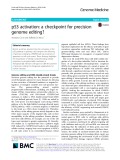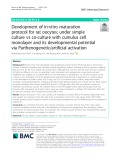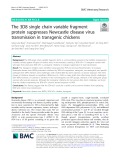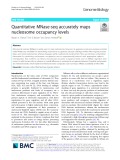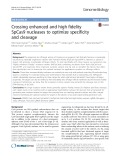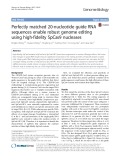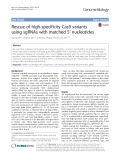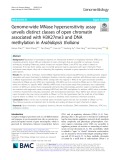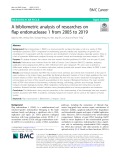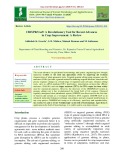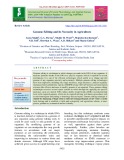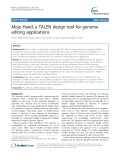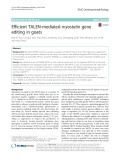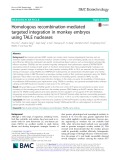
Nuclease activity
-
Recent work has reported that the activation of the p53 pathway in primary cells hampers the efficiency of genome editing by CRISPR/Cas9 via induction of apoptosis or cell cycle arrest. These findings highlight the importance of wholly comprehending cellular responses to programmable nucleases in therapeutically relevant cell types to fulfill the promise of genome editing for therapeutic applications for human diseases.
 4p
4p  vibransone
vibransone
 28-03-2024
28-03-2024
 5
5
 2
2
 Download
Download
-
Murine is the most abundantly used as laboratory animal models. There has been a tremendous amount of research including; their evolution, growth, physiology, disease modeling as well as genomic mapping. Rats and mice are the most widely used among them. Although both rats and mice fall under the same category still both are different a lot too.
 7p
7p  vidarwin
vidarwin
 23-02-2022
23-02-2022
 13
13
 1
1
 Download
Download
-
The 3D8 single chain variable fragment (scFv) is a mini-antibody sequence that exhibits independent nuclease activity against all types of nucleic acids. In this research, crossing a 3D8 scFv G1 transgenic rooster with wild-type hens produced 3D8 scFv G2 transgenic chickens to evaluate suppression of viral transmission.
 6p
6p  vigandhi
vigandhi
 23-02-2022
23-02-2022
 8
8
 1
1
 Download
Download
-
Micrococcal nuclease (MNase) is widely used to map nucleosomes. However, its aggressive endo-/exo-nuclease activities make MNase-seq unreliable for determining nucleosome occupancies, because cleavages within linker regions produce oligo- and mono-nucleosomes, whereas cleavages within nucleosomes destroy them.
 18p
18p  vielonmusk
vielonmusk
 30-01-2022
30-01-2022
 12
12
 0
0
 Download
Download
-
The propensity for off-target activity of Streptococcus pyogenes Cas9 (SpCas9) has been considerably decreased by rationally engineered variants with increased fidelity (eSpCas9; SpCas9-HF1). However, a subset of targets still generate considerable off-target effects.
 17p
17p  vialfrednobel
vialfrednobel
 29-01-2022
29-01-2022
 7
7
 0
0
 Download
Download
-
High-fidelity SpCas9 variants (eSpCas9 and SpCas9-HF1) have been engineered to reduce off-target effects. We found that changes in guide RNA length induced significant reductions in the editing activities of SpCas9 variants in plant cells.
 7p
7p  vialfrednobel
vialfrednobel
 29-01-2022
29-01-2022
 14
14
 0
0
 Download
Download
-
We report that engineered Cas9 variants with improved specificity—eCas9-1.1 and Cas9-HF1—are often poorly active in human cells, when complexed with single guide RNAs (sgRNAs) with a mismatch at the 5’ terminus, relative to target DNA sequences. Because the nucleotide at the 5’ end of sgRNAs, expressed under the control of the commonly-used U6 promoter, is fixed to a guanine, these attenuated Cas9 variants are not useful at many target sites.
 6p
6p  vialfrednobel
vialfrednobel
 29-01-2022
29-01-2022
 6
6
 0
0
 Download
Download
-
The search for novel ways to target and alter the genomes of living organisms accelerated rapidly this decade with the discovery of CRISPR/Cas9. Since the initial discovery, efforts to find alternative methods for altering the genome have expanded.
 4p
4p  viaristotle
viaristotle
 29-01-2022
29-01-2022
 6
6
 0
0
 Download
Download
-
Regulation of transcription depends on interactions between cis-regulatory elements (CREs) and regulatory proteins. Active CREs are imbedded in open chromatin that are accessible to nucleases. Several techniques, including DNase-seq, which is based on nuclease DNase I, and ATAC-seq, which is based on transposase Tn5, have been widely used to identify genomic regions associated with open chromatin
 17p
17p  viarchimedes
viarchimedes
 26-01-2022
26-01-2022
 10
10
 0
0
 Download
Download
-
There is little knowledge, whether in patients with sepsis neutrophil extracellular trap (NET) formation and NET degrading nuclease activity are altered. Thus, we tested the hypotheses that 1) NET formation from neutrophils of septic patients is increased compared to healthy volunteers, both without stimulation and following incubation with mitochondrial DNA (mtDNA), a damage-associated molecular pattern, or phorbol 12-myristate 13-acetate (PMA; positive control) and 2) that serum nuclease activities are increased as well.
 9p
9p  vizhangzhidong
vizhangzhidong
 29-12-2021
29-12-2021
 10
10
 0
0
 Download
Download
-
The simplicity of the CRISPR/Cas9 system has enabled its widespread applications in generating animal models, functional genomic screening and in treating genetic and infectious diseases. However, unintended mutations produced by off-target CRISPR/Cas9 nuclease activity may lead to negative consequences. Especially, a very recent study found that gene editing can introduce hundreds of unintended mutations into the genome, and have attracted wide attention.
 8p
8p  vibeauty
vibeauty
 23-10-2021
23-10-2021
 4
4
 0
0
 Download
Download
-
Flap endonuclease 1 (FEN1) is a structure-specific nuclease that plays a role in a variety of DNA metabolism processes. FEN1 is important for maintaining genomic stability and regulating cell growth and development. It is associated with the occurrence and development of several diseases, especially cancers.
 14p
14p  vianrose2711
vianrose2711
 27-04-2021
27-04-2021
 9
9
 2
2
 Download
Download
-
The recent advances in agricultural biotechnology and genetic engineering have brought numerous benefits to the food and agricultural sector by improving the essential characteristics of plant agronomic traits. Targeted genome editing using sequence specific nucleases (SSNs) provides a general method for inducing targeted deletions, insertions and precise sequence changes in a broad range of organisms and cell types.
 15p
15p  chauchaungayxua11
chauchaungayxua11
 23-03-2021
23-03-2021
 12
12
 2
2
 Download
Download
-
Genome editing is a technique in which changes are made in the DNA of any organism. A nuclease promotes breaks in the DNA at a specific sequence which is repaired by several mechanisms. It is one of the efficient technologies which enable us to change and edit genome of any organism precisely and accurately. Multiple genome editing technologies have been employed, including zinc finger nucleases, mega nucleases, clustered regularly interspaced short palindromic repeats (CRISPR) along with Cas9 protein and transcription activator-like effector nucleases to modify genome of an organism.
 9p
9p  trinhthamhodang1218
trinhthamhodang1218
 26-02-2021
26-02-2021
 13
13
 3
3
 Download
Download
-
Recent studies of transcription activator-like (TAL) effector domains fused to nucleases (TALENs) demonstrate enormous potential for genome editing. Effective design of TALENs requires a combination of selecting appropriate genetic features, finding pairs of binding sites based on a consensus sequence, and, in some cases, identifying endogenous restriction sites for downstream molecular genetic applications.
 7p
7p  viwyoming2711
viwyoming2711
 16-12-2020
16-12-2020
 15
15
 1
1
 Download
Download
-
Myostatin (MSTN) encodes a negative regulator of skeletal muscle mass that might have applications for promoting muscle growth in livestock. In this study, we aimed to test whether targeted MSTN editing, mediated by transcription activator-like effector nucleases (TALENs), is a viable approach to create myostatin-modified goats (Capra hircus).
 8p
8p  viwyoming2711
viwyoming2711
 16-12-2020
16-12-2020
 8
8
 1
1
 Download
Download
-
To achieve global food security, rising agricultural productivity through modern breeding strategies is of prime interest. A variety of biotic and abiotic stresses influences both productivity and crop quality, and it is essential for growing crops with improved adaptability, high productivity and resistance to these biotic/abiotic stresses. Availability of genome sequences helps to improve crop production by using different biotechnological tools.
 8p
8p  kethamoi7
kethamoi7
 26-08-2020
26-08-2020
 16
16
 2
2
 Download
Download
-
The cosmopolitan microcrustacean Daphnia pulex provides a model system for both human health research and monitoring ecosystem integrity. It is the first crustacean to have its complete genome sequenced, an unprecedented ca. 36% of which has no known homologs with any other species.
 8p
8p  viuchiha2711
viuchiha2711
 21-04-2020
21-04-2020
 9
9
 0
0
 Download
Download
-
Non-human primate (NHP) models can closely mimic human physiological functions and are therefore highly valuable in biomedical research. Genome editing is now developing rapidly due to the precision and efficiency offered by engineered site-specific endonuclease-based systems, such as transcription activator-like effector nucleases (TALENs) and the clustered regularly interspaced short palindromic repeats (CRISPR)/CRISPRassociated protein-9 nuclease (Cas9) system.
 10p
10p  vihamax2711
vihamax2711
 21-04-2020
21-04-2020
 12
12
 0
0
 Download
Download
-
emerging field Genome manipulation technology is one of emerging field which brings real revolution in genetic engineering and biotechnology. Genome editing technique is consistent for improving average yield to achieve the growing demands of world‟s existing food famine. Because of their advantages such as simplicity, efficiency, high specificity and amenability to multiplexing, genome editing technologies are revolutionizing the way crop breeding is done and paving the way for next generation breeding.
 19p
19p  nguathienthan2
nguathienthan2
 19-12-2019
19-12-2019
 12
12
 1
1
 Download
Download
CHỦ ĐỀ BẠN MUỐN TÌM








